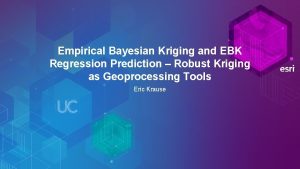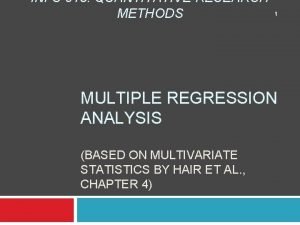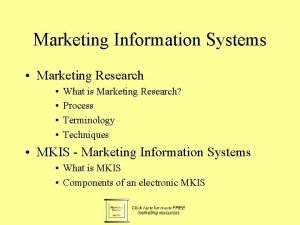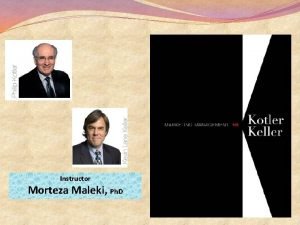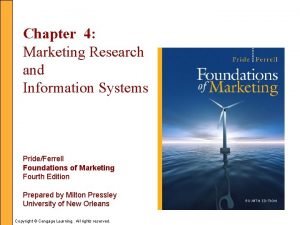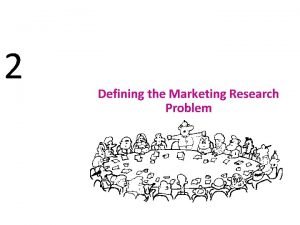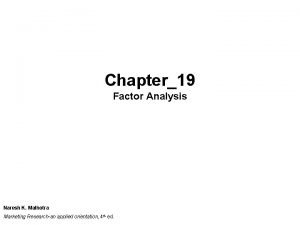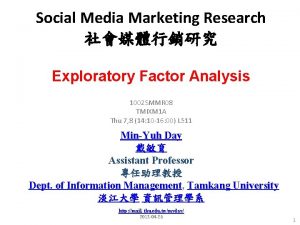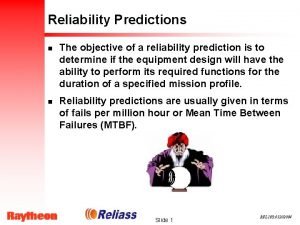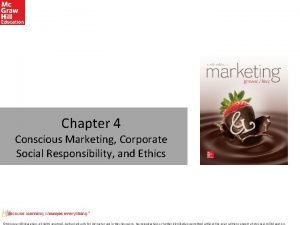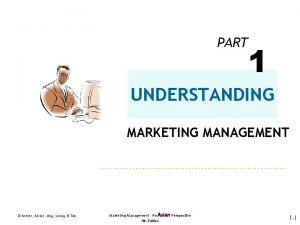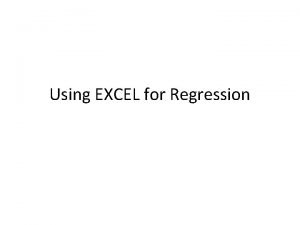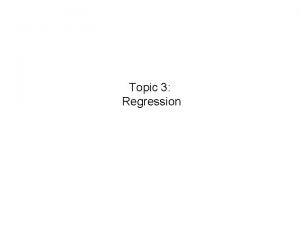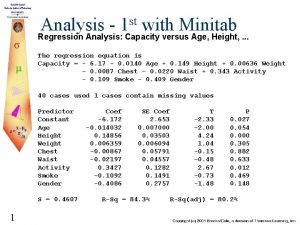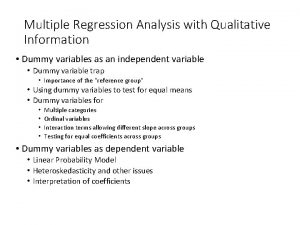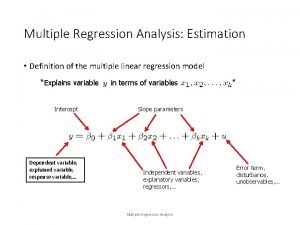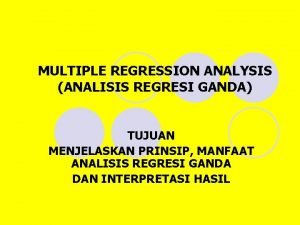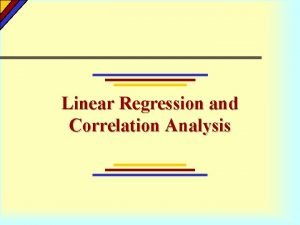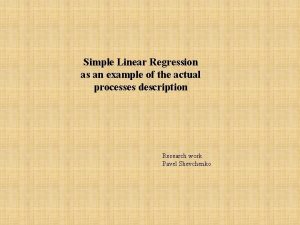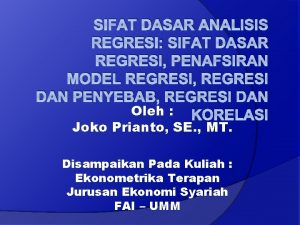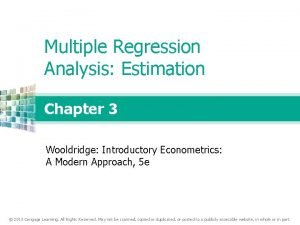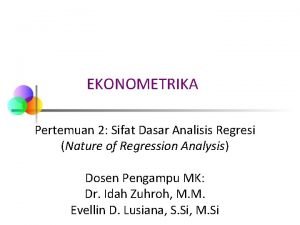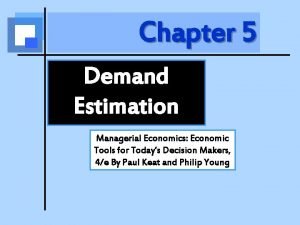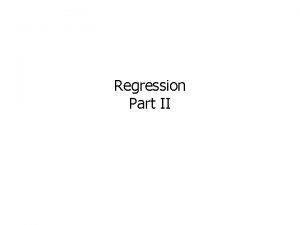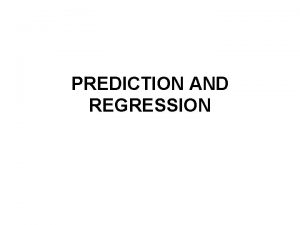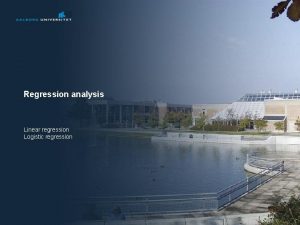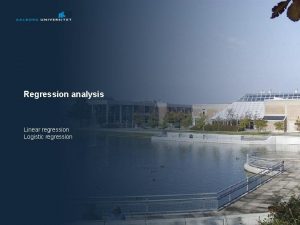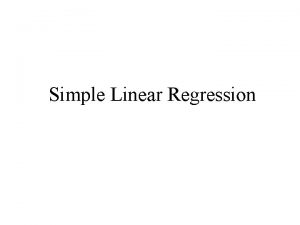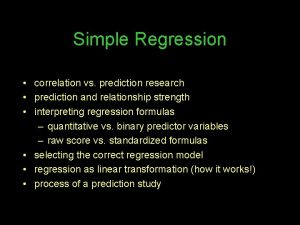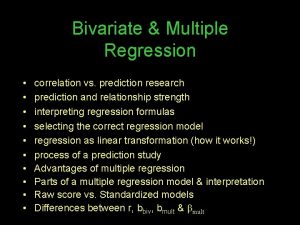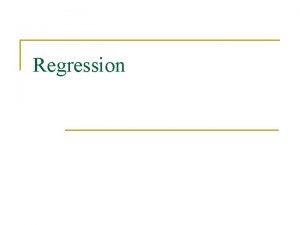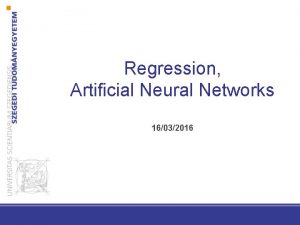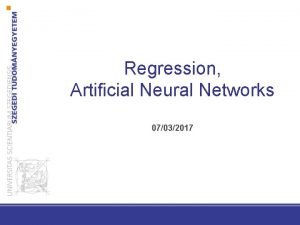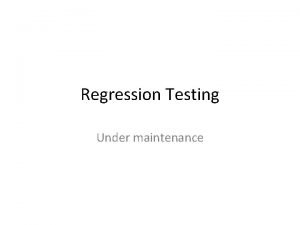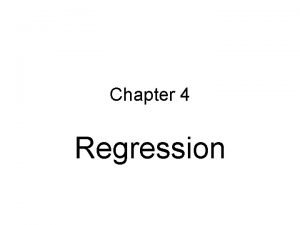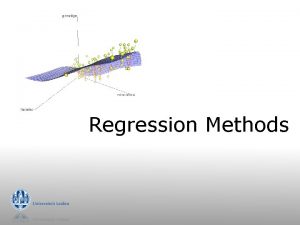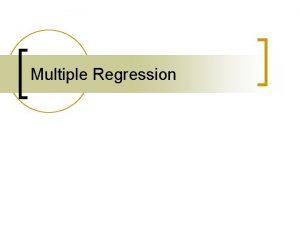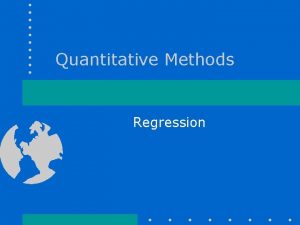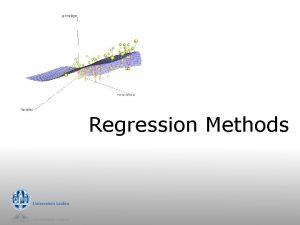Regression Analysis in Marketing Research Understanding Prediction Prediction



































- Slides: 35

Regression Analysis in Marketing Research

Understanding Prediction • Prediction: statement of what is believed will happen in the future made on the basis of past experience or prior observation Ch 19 2

Understanding Prediction Two Approaches • Two approaches to prediction: – Extrapolation: detects a pattern in the past and projects it into the future – Predictive model: uses relationships among variables to make a prediction Ch 19 3

Understanding Prediction Goodness of Prediction • All predictions should be judged as to their “goodness” (accuracy). • The goodness of a prediction is based on examination of the residuals (errors: comparisons of predictions to actual values). Ch 19 4

Analysis of Residuals Ch 19 5

Linear Relationships and Regression Analysis • Regression analysis is a predictive analysis technique in which one or more variables are used to predict the level of another by use of the straight-line formula, y=a+bx. Ch 19 6

Bivariate Linear Regression Analysis • Bivariate regression analysis is a type of regression in which only two variables are used in the regression, predictive model. • One variable is termed the dependent variable (y), the other is termed the independent variable (x). • The independent variable is used to predict the dependent variable, and it is the x in the regression formula. Ch 19 7

Bivariate Linear Regression Analysis • With bivariate analysis, one variable is used to predict another variable. • The straight-line equation is the basis of regression analysis. Ch 19 8

Bivariate Linear Regression Analysis Ch 19 9

Bivariate Linear Regression Analysis: Basic Procedure • Independent variable: used to predict the independent variable (x in the regression straight-line equation) • Dependent variable: that which is predicted (y in the regression straight -line equation) • Least squares criterion: used in regression analysis; guarantees that the “best” straight-line slope and Ch 19 10 intercept will be calculated

Bivariate Linear Regression Analysis: Basic Procedure • The regression model, intercept, and slope must always be tested for statistical significance • Regression analysis predictions are estimates that have some amount of error in them • Standard error of the estimate: used to calculate a range of the prediction made with a regression equation Ch 19 11

Testing for Statistical Significance of the Intercept and the Slope • The t test is used to determine whether the intercepts and slope are significantly different from 0 (the null hypothesis). • If the computed t value is greater than the table t value, the null hypothesis is not supported. Ch 19 12

Making a Prediction Ch 19 13

Bivariate Linear Regression Analysis: Basic Procedure • Regression predictions are made with confidence intervals. Ch 19 14

Multiple Regression Analysis • Multiple regression analysis uses the same concepts as bivariate regression analysis, but uses more than one independent variable. • General conceptual model identifies independent and dependent variables and shows their basic relationships to one another. Ch 19 15

Multiple Regression Analysis: A Conceptual Model Ch 19 16

Multiple Regression Analysis • Multiple regression means that you have more than one independent variable to predict a single dependent variable Ch 19 17

Example of Multiple Regression Ch 19 18

Example of Multiple Regression • We wish to predict customers’ intentions to purchase a Lexus automobile. • We performed a survey that included an attitude-toward-Lexus variable, a word-of-mouth variable, and an income variable. • Here is the result: Ch 19 19

Example of Multiple Regression • This multiple regression equation means that we can predict a consumer’s intention to buy a Lexus level if you know three variables: – Attitude toward Lexus, – Friends’ negative comments about Lexus, and – Income level using a scale with 10 income grades. Ch 19 20

Example of Multiple Regression • Calculation of Lexus purchase intention using the multiple regression equation: • Multiple regression is a powerful tool because it tells us which factors predict the dependent variable, which way (the sign) each factor influences the dependent variable, and even how much Ch 19 (the size of b) each factor influences it. 21

Example of Multiple Regression • Basic assumptions: – A regression plane is used instead of a line – A coefficient of determination (multiple R) indicates how well the independent variables can predict the dependent variable in multiple regression Ch 19 22

Example of Multiple Regression • Basic assumptions: – Independence assumption: the independent variables must be statistically independent and uncorrelated with one another – Variance inflation factor (VIF) can be used to assess and eliminate multicollinearity Ch 19 23

Multiple R • Multiple R: also called the coefficient of determination, is a measure of the strength of the overall linear relationship in multiple regression. Ch 19 24

Multiple R • Multiple R ranges from 0 to +1 and represents the amount of the dependent variable is “explained, ” or accounted for, by the combined independent variables. • Researchers mentally convert the Multiple R into a percentage: Multiple R of. 75 means that the regression findings explain 75% of the Ch 19 dependent variable. 25

Multiple R Ch 19 26

Multiple R Ch 19 27

Multiple R Ch 19 28

Making a Prediction Ch 19 29

Example of Multiple Regression: Special Uses • Special uses of multiple regression: – Dummy independent variable: scales with a nominal 0 -versus-1 coding scheme – Standardized beta coefficient: betas that indicate the relative importance of alternative predictor variables – Multiple regression is sometimes used to help a marketer apply market Ch 19 30 segmentation

Stepwise Multiple Regression • Stepwise regression is useful when there are many independent variables, and a researcher wants to narrow the set down to a smaller number of statistically significant variables. Ch 19 31

Stepwise Multiple Regression Ch 19 – The one independent variable that is statistically significant and explains the most variance is entered into the multiple regression equation – Then each statistically significant independent variable is added in order of variance explained – All insignificant independent 32 variables are eliminated

Three Warnings Regarding Multiple Regression Analysis • Regression is a statistical tool, not a cause-and-effect statement. • Regression analysis should not be applied outside the boundaries of data used to develop the regression model. • Chapter 19 is simplified…regression analysis is complex and requires additional study. Ch 19 33

Regression Analysis Ch 19 34

Regression Analysis Ch 19 35
 Empirical bayesian kriging
Empirical bayesian kriging Simple linear regression and multiple regression
Simple linear regression and multiple regression Regression linear model
Regression linear model Survival analysis vs logistic regression
Survival analysis vs logistic regression Logistic regression vs linear regression
Logistic regression vs linear regression Multiple regression research design
Multiple regression research design Finer segmentation strategy
Finer segmentation strategy Marketing information systems and marketing research
Marketing information systems and marketing research Define marketing information management
Define marketing information management Marketing information systems and marketing research
Marketing information systems and marketing research Marketing information system kotler
Marketing information system kotler Marketing information systems and marketing research
Marketing information systems and marketing research Marketing research problem definition
Marketing research problem definition Factor analysis marketing
Factor analysis marketing Factor analysis in marketing research
Factor analysis in marketing research Reliability
Reliability Conscious marketing definition
Conscious marketing definition Value proposition kotler
Value proposition kotler Marketing meaning in marketing management
Marketing meaning in marketing management Marketing management definition
Marketing management definition What is grounded theory in simple terms
What is grounded theory in simple terms Regression analysis excel 2007
Regression analysis excel 2007 Disadvantages of regression analysis
Disadvantages of regression analysis Minitab linear regression
Minitab linear regression Vif in regression spss
Vif in regression spss Multiple regression analysis with qualitative information
Multiple regression analysis with qualitative information Explanatory variable definition
Explanatory variable definition Multiple regression analysis adalah
Multiple regression analysis adalah Example of regression analysis
Example of regression analysis Trendlines and regression analysis
Trendlines and regression analysis Multiple linear regression analysis formula
Multiple linear regression analysis formula Sifat analisis regresi
Sifat analisis regresi Multiple regression analysis estimation
Multiple regression analysis estimation Dataset multiple linear regression
Dataset multiple linear regression The nature of regression analysis
The nature of regression analysis Demand estimation in managerial economics
Demand estimation in managerial economics
